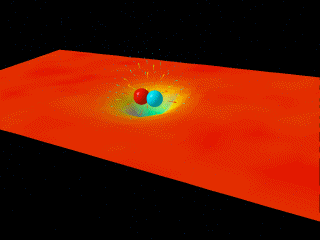Wonder Quest with April
Holladay

Why do shrimp turn orange when they are cooked? Where did the
missing license plate letters go?
For answers to these and other conundrums, check out Wonder Quest.
April's column appears every month in NMSR Reports.

April Holladay, author of Wonder Quest
Look for past columns at Wonder
Quest
Go
ahead - you know you want to - so, ask April a question!

Wonder Quest column for January 2008: Vacuum — where nothing weighs something
Q: What is Vacuum, such as in Space, is there vacuum between the atoms of water molecules? Is Vacuum a squishable-stretchable thing? oooo, this fascinates me. Andre, Vancouver, Canada
A: A perfect vacuum. Ah, for the good old days of Aristotle and Newton, when we simply thought of a perfect vacuum as a volume of completely empty space, containing nothing. Such a volume would have zero pressure.

A look at 'vacuum energy.' The animation shows the inside of a proton where a quark and an anti-quark pop into existence, causing a hole in the vacuum-field fluctuations. (Three quarks make up a proton. Protons and electrons make up atoms; atoms make up molecules.)
The two spheres represent the quark and anti-quark. The tube between them depicts the hole. Animation courtesy of Derek B. Leinweber, CSSM, University of Adelaide, copyright, used with permission.
Nonsense, Plato said. There can never be nothing.
Now we know Plato was right, but for reasons that don't make intuitive sense. Consider an electron. It's both a particle and a wave. Since it has wave-like properties, its position is smeared out. According to the Heisenberg Uncertainty Principle, we can never know both the electron's exact position and momentum at the same time. But that means any small volume of space could have particles within it, which means no volume of space can ever be a perfect vacuum, for certain.
There's also another effect involving gluons (which are tiny massless particles that 'glue' quarks together inside a proton), says physicist Derek B. Leinweber http://www.physics.adelaide.edu.au/theory/staff/leinweber/index.html, professor at University of Adelaide in Australia. Suppose we had an empty vacuum. It won't stay empty long, because if we drop a single gluon into it — the vacuum becomes unstable. It changes! The single gluon triggers the creation of a "sea" of interacting quarks and gluons — in the vacuum. The sea seethes with energy, and releases that energy in huge quantities.
So, to answer your question, no perfect vacuum exists between the atoms of water molecules.
Experimental evidence. Moreover, not just theory, but also experimental evidence (the Casimir effect) suggests vacuum is not empty. Put two metallic plates close together — about a tenth of a micron (the length of the smallest bacteria on Earth). Vacuum energy causes a measurable attractive force between them. "In fact, this force can be the dominant force in the micro world," physicist Erik Ramberg http://beamdocs.fnal.gov/AD-public/DocDB/ListBy?authorid=471 of Fermilab emails. "It is related to the Van der Waals forces that exist between millions of individual water molecules. Even the stickiness of a gecko's foot can be fundamentally related to these tiny vacuum forces. Crazy!"
The Casimir effect is similar to the pull between tall sailing ships. Long ago, when two schooners sailed side-by-side and sufficiently close together in rough seas, they pulled together and actually crashed. Sailors had no idea why. We now know it's because only certain length ocean waves can fit in the space between the two close-together ships. But all-length waves travel the open ocean. The inside waves tend to push out just as the outside waves tend to push in. The few waves inside don't have a chance in this shoving match. The huge numbers outside overcome the inside ones, and push the ships together.
Similarly, the photons that pop into and out of existence in a vacuum have wave-like properties, and exhibit all wavelengths. But only certain wavelengths fit between the two plates. So the outside waves overcome the inside ones, and push the plates towards each other a measurable amount.
The density of space vacuum. The vacuum of space between stars is about hundred trillion times less dense than .the vacuum in a thermos bottle. A cubic centimeter of interstellar space — about the volume of a standard shooting marble — holds, on the average, a single hydrogen atom. That's it, usually. That marble-sized volume could also hold cosmic dust, but dust is found about 1000 times less often.
A squishable-stretchable thing? Your question about vacuum being a squishable-stretchable thing is, indeed, fascinating stuff, which physicists fight about and outrages our intuition. As mentioned above, we live in a universe of particles and anti-particles that constantly wink into and out of existence in pairs so quickly they can violate a strict relationship between the particle's energy and momentum, and get away with it. The particles borrow energy from the vacuum to pop into existence, and pay it back by annihilating each other in a flash of energy. So, the vacuum energy constantly changes — bigger sometimes, and smaller other times. The change can be enormous, and may account for the origin of our Universe.
The sea of particles, thus, roils with energy, which is present even at absolute zero (-273 degrees Celsius) and when no stable matter is present. We call this energy 'vacuum energy' and 'zero-point energy.'
Vacuum energy's origin. Where vacuum energy came from originally is debatable. One group thinks it's left over energy from the big bang. Another says it came from randomly foaming energy existing before the big bang and, indeed, is the giant fluctuation that produced our universe.
Physicists also disagree about the amount of energy in empty-space vacuum. Harold E. Puthoff, a quantum physicist at the Institute for Advanced Studies at Austin, Texas states there's enough such energy in a coffee-cup sized space to evaporate all Earth's oceans. Cosmic physicist Steven Weinberg of the University of Texas, a Nobel-prize winner, says the amount of energy in an Earth-sized space probably is equivalent to a gallon of gasoline.
Why the tremendous disparity? We have no theory that predicts gravity effects on fundamental particles. The theories we do have — quantum mechanics for small-scale particle interaction and gravity for large-scale object interaction — are not appropriate for gravity effects on particles, and thus disagree wildly. A new physics involving perhaps extra dimensions may eventually do the job, accurately. But we're not there yet.
Back to your question, space vacuum is stretchable in the sense that its energy apparently has changed from something close to Puthoff's value (huge) at the time of the big bang to something close to Weinberg's value (tiny) now. How did it change? We don't know, yet.
Further Reading:
Visualizations of quantum chromodynamics, Centre for the Subatomic Structure of Matter and Department of Physics, University of Adelaide, Australia
The five ages of the Universe, Fred C. Adams, Greg Laughlin, 1999.
New energy age, Ask the experts, Scientific American frontiers archives, PBS
The quantum designer, Harvard Magazine, Jan-Feb 2005
Zero-point energy, Calphysics Institute
Bacteria, Sizes.com
What is the 'zero-point energy' (or 'vacuum energy') in quantum physics?, Scientific American, Aug. 18, 1997
Van der Waal forces, PhysLink.com
Density of outer space, The Physics Fact Book
Vacuum, Wikipedia
(Answered Dec. 10, 2007)

APRIL IS A COLUMNIST AT USA TODAY!
You can find a link to her USA Today
columns here.
You can also read April's syndicated columns at
the Globe
and Mail (the second Monday of the
month), and at Happy
News (Mondays)!!
Congratulations
April!!

NMSR Site
Map
![]()

